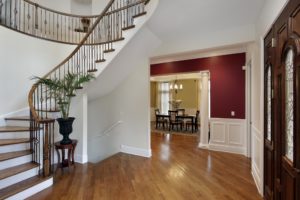Our craving for nature strengthened during the COVID-19 pandemic and the quarantine restrictions that were enforced. We were encouraged to stay inside our homes so that we could stop the virus would stop spreading. While, of course, our and other people’s health safety take high priority, that doesn’t mean we’re totally happy about it. Staying indoors at all hours of the day affected our mood, relationships, and productivity.
Connecting to the natural world seems crucial now after spending months in quarantine. And there’s no better way to do so than through the design of our homes. When you start thinking about having your dream home built, you can rely on the advice of one of the most iconic architects of all time: Frank Lloyd Wright. He created organic architecture, a whole architectural philosophy that promotes humans’ capacity to live, build, and thrive with nature.
Frank Lloyd Wright
Before Frank Lloyd Wright became one of the leading experts in American architecture, he was an engineering student from a family struggling with financial issues. But his engineering mindset influenced how he perceived infrastructure. But he took his studies further by learning about architecture mostly on his own. His sharp mind, vast knowledge and skills, and innovative way of seeing the world saw him through. He found the potential of redefining the idea of American homes.
That’s what he became best known for—his modern approach to building homes. He was dedicated to innovating how people lived in their homes and how such homes could influence their daily lives. Eventually, he became driven by a whole new philosophy in architecture: organic architecture.
Wright died in 1959, but his impact on the world of architecture remains. People continue to remember him for his radical perception of how people could own houses and coexist with nature.

Organic Architecture
Wright first coined the term “organic architecture” in an article published in Architectural Record in 1914. It became the basis of his creative style. Organic architecture is rooted in humans’ connection to nature.
Through this philosophy, he created homes that embody natural forms and principles. This is why his designs mostly have earthy colors–shades of green and brown. His homes also tend to break the distinction between indoors and outdoors. This is why many of his designs tend to have massive windows and doors. He also liked to incorporate natural textures into the walls and floors of his homes. He used wood and stone.
The reasoning behind these designs is that he believed in a home’s organic connection to the world. He envisioned and built homes that appear as if they’re growing right from the ground.
To understand how you, too, can have a home similar to Wright’s creations, here are some elements that embody organic architecture.
Building and Site
When daydreaming about our future homes, we start with the location. If you want a more relaxing and sunny life, you must be thinking of living on a beach. If you want a more secluded and quiet life, then you must be thinking of a home that’s quite near a forest. Either way, according to Wright, the texture, colors, and other materials of your house should blend well with its surroundings.
Openness to Nature
The next step to blending well with nature is opening your home to it. This means lots of massive windows that let natural air and sunlight in. Having such a house could certainly help us quarantine situations. That way, we would never feel stuffy and overwhelmed by enclosed spaces for long periods of time. But it’s important to note that being too open to nature has a downside in some cases. This case can often apply to greenhouses. You have to control the amount of sunlight that plants are getting through window shades designed for greenhouses.
Furniture and Ornaments
This might seem like the most radical aspect of organic architecture. But Wright believed that furniture and ornaments need to be integrated into the house itself. This meant having shelves, benches, and even tables built into the walls and floors.
Houses that are more open to nature has always been a trend. Plants are no longer just outside. They also inside our homes. We tend to believe that no chandelier or other fancy light fixtures could beat natural sunlight. We also feel calm and clear-headed if our houses are full of natural air. It didn’t matter if we lived in the country or in the city. We also want to be more connected to nature. Wright showed us a way how through organic architecture.














